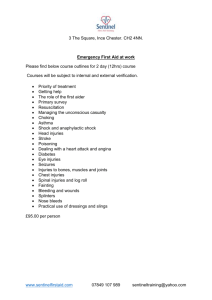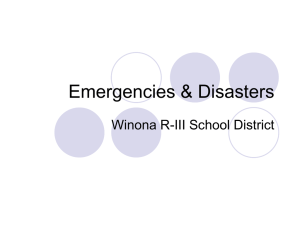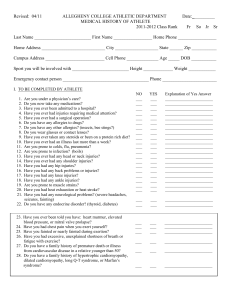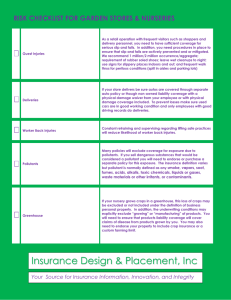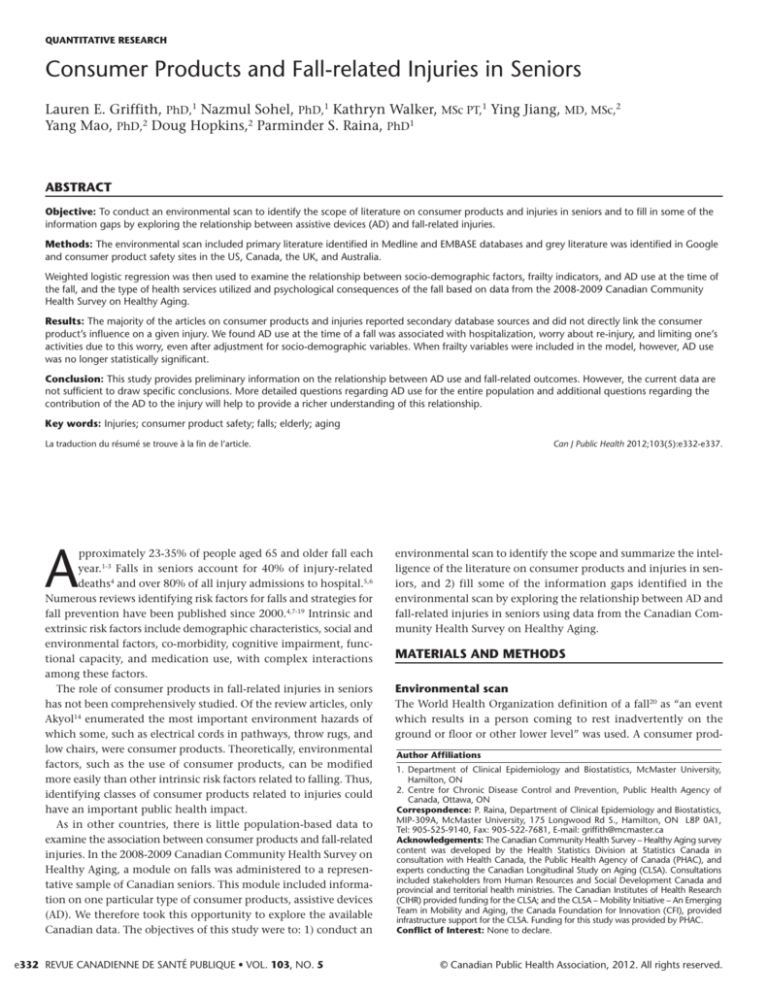
QUANTITATIVE RESEARCH
Consumer Products and Fall-related Injuries in Seniors
Lauren E. Griffith, PhD,1 Nazmul Sohel, PhD,1 Kathryn Walker, MSc PT,1 Ying Jiang, MD, MSc,2
Yang Mao, PhD,2 Doug Hopkins,2 Parminder S. Raina, PhD1
ABSTRACT
Objective: To conduct an environmental scan to identify the scope of literature on consumer products and injuries in seniors and to fill in some of the
information gaps by exploring the relationship between assistive devices (AD) and fall-related injuries.
Methods: The environmental scan included primary literature identified in Medline and EMBASE databases and grey literature was identified in Google
and consumer product safety sites in the US, Canada, the UK, and Australia.
Weighted logistic regression was then used to examine the relationship between socio-demographic factors, frailty indicators, and AD use at the time of
the fall, and the type of health services utilized and psychological consequences of the fall based on data from the 2008-2009 Canadian Community
Health Survey on Healthy Aging.
Results: The majority of the articles on consumer products and injuries reported secondary database sources and did not directly link the consumer
product’s influence on a given injury. We found AD use at the time of a fall was associated with hospitalization, worry about re-injury, and limiting one’s
activities due to this worry, even after adjustment for socio-demographic variables. When frailty variables were included in the model, however, AD use
was no longer statistically significant.
Conclusion: This study provides preliminary information on the relationship between AD use and fall-related outcomes. However, the current data are
not sufficient to draw specific conclusions. More detailed questions regarding AD use for the entire population and additional questions regarding the
contribution of the AD to the injury will help to provide a richer understanding of this relationship.
Key words: Injuries; consumer product safety; falls; elderly; aging
La traduction du résumé se trouve à la fin de l’article.
A
pproximately 23-35% of people aged 65 and older fall each
year.1-3 Falls in seniors account for 40% of injury-related
deaths4 and over 80% of all injury admissions to hospital.5,6
Numerous reviews identifying risk factors for falls and strategies for
fall prevention have been published since 2000.4,7-19 Intrinsic and
extrinsic risk factors include demographic characteristics, social and
environmental factors, co-morbidity, cognitive impairment, functional capacity, and medication use, with complex interactions
among these factors.
The role of consumer products in fall-related injuries in seniors
has not been comprehensively studied. Of the review articles, only
Akyol14 enumerated the most important environment hazards of
which some, such as electrical cords in pathways, throw rugs, and
low chairs, were consumer products. Theoretically, environmental
factors, such as the use of consumer products, can be modified
more easily than other intrinsic risk factors related to falling. Thus,
identifying classes of consumer products related to injuries could
have an important public health impact.
As in other countries, there is little population-based data to
examine the association between consumer products and fall-related
injuries. In the 2008-2009 Canadian Community Health Survey on
Healthy Aging, a module on falls was administered to a representative sample of Canadian seniors. This module included information on one particular type of consumer products, assistive devices
(AD). We therefore took this opportunity to explore the available
Canadian data. The objectives of this study were to: 1) conduct an
e332 REVUE CANADIENNE DE SANTÉ PUBLIQUE • VOL. 103, NO. 5
Can J Public Health 2012;103(5):e332-e337.
environmental scan to identify the scope and summarize the intelligence of the literature on consumer products and injuries in seniors, and 2) fill some of the information gaps identified in the
environmental scan by exploring the relationship between AD and
fall-related injuries in seniors using data from the Canadian Community Health Survey on Healthy Aging.
MATERIALS AND METHODS
Environmental scan
The World Health Organization definition of a fall20 as “an event
which results in a person coming to rest inadvertently on the
ground or floor or other lower level” was used. A consumer prodAuthor Affiliations
1. Department of Clinical Epidemiology and Biostatistics, McMaster University,
Hamilton, ON
2. Centre for Chronic Disease Control and Prevention, Public Health Agency of
Canada, Ottawa, ON
Correspondence: P. Raina, Department of Clinical Epidemiology and Biostatistics,
MIP-309A, McMaster University, 175 Longwood Rd S., Hamilton, ON L8P 0A1,
Tel: 905-525-9140, Fax: 905-522-7681, E-mail: griffith@mcmaster.ca
Acknowledgements: The Canadian Community Health Survey – Healthy Aging survey
content was developed by the Health Statistics Division at Statistics Canada in
consultation with Health Canada, the Public Health Agency of Canada (PHAC), and
experts conducting the Canadian Longitudinal Study on Aging (CLSA). Consultations
included stakeholders from Human Resources and Social Development Canada and
provincial and territorial health ministries. The Canadian Institutes of Health Research
(CIHR) provided funding for the CLSA; and the CLSA – Mobility Initiative – An Emerging
Team in Mobility and Aging, the Canada Foundation for Innovation (CFI), provided
infrastructure support for the CLSA. Funding for this study was provided by PHAC.
Conflict of Interest: None to declare.
© Canadian Public Health Association, 2012. All rights reserved.
CONSUMER PRODUCTS AND FALL-RELATED INJURIES IN SENIORS
Table 1.
Summary of Literature Identified in Environmental Scan
Characteristic
N (%)
Notes
Geographic Scope
International
National
Regional
State/Provincial
City
2 (9.5)
10 (47.6)
2 (9.5)
6 (28.6)
1 (4.8)
International: Comparison of Australia, US, UK and the Netherlands and countries within the European Union
National: Australia, Canada, US, Ireland
Regional: Atlantic Provinces (Canada), Västmanland County (Sweden)
State/Provincial: Victoria (Australia), Massachusetts (US), Ontario (Canada)
City: Dublin (Ireland)
Type of Data Analyzed
Primary
Secondary
Both
1 (4.8)
18 (85.7)
2 (9.5)
Primary Data: Telephone survey, questionnaires
Secondary Data: Hospital discharge data, emergency department data, mortality records, retrospective chart review
Data Sources
Mortality data
Hospital discharge data
Emergency department data
Time off work
8 (38.1)
17 (81.0)
16 (76.2)
1 (4.8)
Injury Surveillance Systems: Many injury surveillance databases included data from multiple administrative
databases (mortality data, hospital discharge data, and emergency department data)
Injury Type
All unintentional injuries
Falls
Both (comparison)
8 (38.1)
12 (57.1)
1 (4.8)
Injuries: All reported injuries associated with a consumer product
Falls: All fall-related injuries associated with a consumer product
One study compared falls vs. other non-fall injuries
Consumer Products
General
8 (38.1)
Ladders and/or steps and stairs 10 (47.6)
Sports equipment
1 (4.8)
Wheelchairs and adult walkers 1 (4.8)
Bathroom products
1 (4.8)
Time off work: Self-reported questionnaire data
The most commonly identified consumer products related to injuries: Floors/flooring, stairs/steps, beds, chairs,
rugs/carpets, ladders, footwear, outdoor structures, and housing/building materials
Only one study reported the characteristics of the injury event, including whether product fault was the cause of
the accident
uct was defined as “any article produced or distributed for sale to a
consumer for use in or around a household or residence, a school,
in recreation, or otherwise”.21 An AD was defined as any device or
system that allows an individual to perform a task that they would
otherwise be unable to do, or increases the ease and safety with
which the task can be performed.
Literature search
Review articles, primary and grey literature were identified by a
research librarian. Medline and EMBASE databases were searched
using terms for “consumer products” and “falls OR injuries”. Reference lists of included articles were reviewed to identify additional literature. Grey literature was identified using the same terms in
Google and consumer product safety sites in the US, Canada, the
UK, and Australia. These results were supplemented by searches to
identify literature for key types of consumer products: ladders, floor
coverings, rugs, carpets, bathroom products.
Screening and data abstraction
Articles including information on at least one consumer product
and injuries in older adults (≥45 years) were included. Abstracts
were screened by a single reviewer (KW). Any questions regarding
inclusion were resolved by a second reviewer (LG, PR). Study
design, population, type of consumer products, injury characteristics, and whether the study included primary or secondary data
were abstracted from each included article.
Canadian Community Health Survey (CCHS) - Healthy
Aging
The CCHS-Healthy Aging includes community-dwelling people
aged 45 years and over living in the ten Canadian provinces.
Excluded from the sample were residents of the three territories;
persons living on Indian reserves, Crown lands or in institutions;
full-time members of the Canadian Forces; and residents of some
remote regions. Data collection took place in participants’ homes
from December 1, 2008 through November 30, 2009 using
computer-assisted personal interviewing.
The content of the CCHS-Healthy Aging was developed collaboratively by Statistics Canada and researchers from the Canadian
Longitudinal Study on Aging (CLSA).22 As part of the Statistics
Canada-CLSA collaboration, CCHS participants were asked whether
their survey data could be shared with the CLSA. This article
includes data from CCHS participants who were between the ages
of 45 and 85 years and who agreed to share their data with the
CLSA, henceforth referred to as the CCHS-CLSA sample.
Measurement
Participants aged 65 years and older were asked whether they had
sustained a fall in the previous 12 months in which they were hurt
enough to limit some of their normal activities. Those reporting a
fall were asked about the severity, nature, consequent health care
resource utilization resulting from their fall, and whether they were
using an AD at the time of their fall. If a participant had more than
one fall, they were asked to describe their most “serious injury or
problem due to a fall”. Fallers were asked whether they were concerned about future falls and if, as a result of this concern, they had
stopped doing some activities.
Regression analyses were adjusted for a core set of socio-demographic
factors (age, sex, marital status, education, and household income)
and whether a participant reported having had more than one fall
in the previous 12 months. These are known risk factors of falling
and could be related to AD use.23 Socio-demographic factors were
categorized according to Statistics Canada documentation,24
although some categories were collapsed due to low cell frequencies. Age was represented by five-year groups (65-69, 70-74, 75-79,
and 80-85), marital status was represented as three categories (married/common-law, widowed/divorced/separated, and single/never
married), education was categorized into post-secondary versus
<post-secondary, and income was included as <$30,000 CDN vs.
≥$30,000 CDN.
Clinical frailty has also been shown to be associated with morbidity, institutionalization and mortality in people 65 years of age
and older.25 Because frailty would also be associated with AD use, we
examined whether there was an independent effect of AD use after
CANADIAN JOURNAL OF PUBLIC HEALTH • SEPTEMBER/OCTOBER 2012 e333
CONSUMER PRODUCTS AND FALL-RELATED INJURIES IN SENIORS
Table 2.
Weighted Prevalence of Falls Serious Enough to Limit Some Normal Activities in the Previous 12 Months in Relation to
Socio-demographic Factors for Canadians Aged 65-85 Years
Variable
Overall
Sex
Male
Female
Age (years)
65-69
70-74
75-79
80-85
Marital status
Married/Common-law
Widowed/separated/divorced
Single
Education
Less than post-secondary
Post-secondary graduation
Income
<$30,000
$30,000-$49,999
Number of Chronic Conditions
<5
≥5
Weighted Prevalence
0.20
95% Confidence Interval
(0.19-0.21)
0.18
0.22
(0.16-0.20)
(0.20-0.24)
0.18
0.18
0.22
0.24
(0.16-0.20)
(0.16-0.20)
(0.20-0.24)
(0.21-0.27)
0.18
0.23
0.20
(0.17-0.20)
(0.22-0.25)
(0.15-0.25)
0.20
0.20
(0.18-0.22)
(0.18-0.22)
0.22
0.19
(0.20-0.24)
(0.18-0.21)
0.17
0.28
(0.16-0.19)
(0.26-0.31)
P-value for Difference
<0.001
<0.001
<0.001
0.39
0.004
<0.001
CCHS = Canadian Community Health Survey; CLSA = Canadian Longitudinal Study on Aging; CI = confidence interval.
adjusting for frailty. Three frailty variables represented the domains
of the clinical frailty scale developed by Rockwood et al.25: level of
physical activity, medical problems, and activity limitations. The
Physical Activity Scale for the Elderly (PASE) was used to characterize physical activity.26 The PASE scale incorporates leisure time,
household, and work-related activities carried out in the previous
week. Medical problems were characterized as the number of selfreported health professional-diagnosed chronic conditions. The
CCHS collected information on 26 respiratory, musculoskeletal,
cardiovascular, neurological, vision-related, and mental health conditions and cancer. A cut-point of 5 or more was used to represent
a higher level of co-morbidities. Activity limitations were characterized using the instrumental and basic activities of daily living
(ADL).27 We categorized participants as having any versus no functional impairment.
Statistical analysis
The CCHS used a multistage stratified cluster design to select participants. To correct the potential bias resulting from this complex
survey design, we used bootstrapping of all tests according to a set
of replicate weights supplied by Statistics Canada for the CCHSCLSA sample. Similarly, statistics dependent on standard errors are
adjusted for survey design effects (i.e., the ratio of an estimated variance based on the survey to a comparable estimated variance from
a random sample of the population).
Using a bootstrap method, sampling weights were used to estimate the prevalence and 95% confidence interval of having at least
one fall serious enough to limit some normal activities in the previous 12 months for the Canadian population between the ages
65-85 years. Estimates were also provided for subgroups of the populations based on socio-demographic and health status factors.
Weighted logistic regression was used to examine the relationship
between AD use at the time of the fall and socio-demographic and
frailty indicators, and the relationship between AD use at the time
of the fall and the type of health services utilized and psychological consequences of the fall. Dependent variables included: whether
medical attention was received, hospitalization, whether follow-up
care was received, worry about future falls, and limiting activities
e334 REVUE CANADIENNE DE SANTÉ PUBLIQUE • VOL. 103, NO. 5
due to this worry. For each dependent variable, an unadjusted OR,
an OR adjusted for socio-demographic factors, and an OR adjusted
for demographic and frailty variables were estimated. All reported
p-values are two-sided. Analyses were conducted using SAS version
9.2.28
Regression analyses were limited to participants with complete
data for all variables. Because the majority of missing data were for
income, we conducted sensitivity analyses in which the median
income was imputed for missing cases. Participants with missing
income data were categorized in the ≥$30,000 CDN group.
RESULTS
Environmental scan
The literature search yielded 40 citations, of which 21 directly
addressed the association of consumer products with injuries in
older adults (Table 1; Supplemental Table 1). The majority of the
articles reported secondary database sources.29-45 Two included both
primary and secondary data,46,47 and one collected primary data.48
Of the three studies in which primary data were collected, one used
an adaptation of the Nordic Medico-Statistical Committee
(NOMESCO) classification46 of products,47 one used a list of product codes developed by the Council of Ministries of the European
Union,49 and one developed their own survey tool to collect information on consumer products.48
Most of the reports (57.1%) presented national or international
data. All studies included either hospital and/or emergency department admissions; eight studies29,31,32,35,41,42,45,49 (38.1%) also included mortality data, and one study included information on injuries
that required time off work.48 Of the 21 studies, 10 focused on ladders and/or steps and stairs,33-35,37,39-43,50 one focused on wheelchairs
and adult walkers,39 one included only sports products,38 and one
included only bathroom products.30 The remaining articles29,31,32,36,45,47-49 described the mortality and morbidity associated
with a broad spectrum of consumer products. The most commonly identified consumer products related to injuries were floors/flooring, stairs/steps, beds, chairs, rugs/carpets, ladders, footwear,
outdoor structures, and housing/building materials. Only one
CONSUMER PRODUCTS AND FALL-RELATED INJURIES IN SENIORS
Table 3.
Weighted Logistic Regression Results Examining the Association of Assistive Device Use at the Time of the Fall and Fallrelated Health Care and Psychological Consequences in Canadians 65-85 Years of Age
Unadjusted
Outcome
Received medical attention
Hospitalized for injury
Follow-up care from a health professional
Worried about re-injury
Limits activities due to worry about re-injury
OR (95% CI)
1.64 (0.88-3.02)
3.70 (1.54-8.90)
1.02 (0.47-2.21)
2.81 (1.56-5.07)
3.79 (2.09-6.86)
P-value
0.12
0.003
0.95
<0.001
<0.001
Adjusted for
Socio-demographic Factors*
OR (95% CI)
P-value
1.54 (0.82-2.87)
0.18
3.36 (1.26-8.92)
0.02
0.98 (0.45-2.12)
0.96
2.43 (1.31-4.49)
0.005
3.22 (1.69-6.12)
<0.001
Adjusted for Socio-demographic
and Frailty Factors†
OR (95% CI)
P-value
1.24 (0.65-2.38)
0.51
1.87 (0.72-4.86)
0.20
0.64 (0.28-1.45)
0.28
1.50 (0.73-3.07)
0.27
1.91 (0.94-3.90)
0.07
* Analyses adjusted for age, sex, income, marital status, education, >1 fall in previous 12 months.
† Analyses adjusted for age, sex, income, marital status, education, >1 fall in previous 12 months, 5 or more chronic conditions, any ADL/IADL impairment, and
physical activity level.
OR = odds ratio; CI = confidence interval.
study48 reported the characteristics of the injury event and whether
product fault was the cause of the accident.
CCHS-CLSA data
In total, 30,865 people aged 45 years and over participated in CCHSHealthy Aging. The overall response rate was 74.4%; the response
rate in participants 65-84 was 75.4%.51 Of these respondents, 26,248
(85.0%) met the additional CLSA eligibility criterion of being
between 45-85 years old, and 20,087 (76.5%) agreed to share their
data with the CLSA. Of these participants, 9,108 (45.3%) were 65-85
years of age and 9,106 (99.9%) completed the Falls module.
Complete data were available for 7,712 (84.7%) participants.
Compared to those with incomplete data, participants with complete data were more likely male (45% vs. 33.7%), slightly younger
(73.4±5.9 vs. 74.4±6.0), and reported no functional impairments
(80.5% vs. 75.9%). The groups did not differ with respect to marital status, education level, or number of chronic conditions.
The data from these participants represent approximately
4.0 million Canadians aged between 65-85 years, of whom almost
800,000 (20%) experienced a fall in the previous 12 months. About
two thirds of the falls were serious enough to limit normal activities. Over one third of participants reported more than one fall in
the previous 12 months. The 12-month prevalence of falls differed
by demographic characteristics (Table 2). A higher prevalence of
falls was associated with being female, older, widowed, separated or
divorced, earning less money, and having more chronic conditions.
About 6% of the fallers reported using an AD at the time of their
fall. The odds of using an AD at the time of the fall were higher for
participants who had ADL limitations (OR 4.16, 95% CI: 2.07-8.36),
and for those with a lower level of physical activity (OR 0.87, 95%
CI: 0.79-0.97 for a difference of 20 points PASE score).
The unadjusted ORs were statistically significant for hospitalization for injury (OR 3.70, 95% CI: 1.54-8.9), worried about re-injury
(OR 2.81, 95% CI: 1.56-5.01), and limiting activities due to worry
about re-injury (OR 3.79, 95% CI: 2.09-6.86) (Table 3). After adjusting for the socio-demographic factors, the magnitude of the ORs
was slightly attenuated but still statistically significant. After adjusting for the frailty variables, AD use at the time of the fall was no
longer statistically significant. The sensitivity analyses in which
median income was imputed for participants not reporting income
did not result in qualitatively different results (results not shown).
DISCUSSION
In our environmental scan, we found a dearth of information on
the association between consumer products and injuries in older
adults. The current literature lacks a clear link between consumer
products, the product’s influence on a given injury, and the age of
the subject when a given injury occurred. At present, most of the
data available come from administrative databases, which have
non-specific coding of consumer products and little information
on the role of the consumer product in the injury. There are very
little data for the 45-64 year age group.29,49
Using the CCHS-CLSA sample, it was estimated that about 48,000
(6.1%) Canadians 65-85 years of age were using an AD at the time
of their reported fall. In a prospective case series study, Zecevic et
al.52 used the Seniors Falls Investigation Methodology to investigate falls in 15 community-dwelling seniors in London, Ontario.
Although it was not a random sample, they reported that 3 of the
15 fallers (20%) were using an AD at the time of their fall. The
Health and Activity Limitation Study (HALS) indicated that 35%
of Canadians 75 years of age and older used an AD.53 In the CCHS,
AD-use data were not collected outside of the falls questions, thus
we do not know how many people who regularly use an AD were
not using it at the time of their fall.
We found AD use at the time of a fall was associated with hospitalization, worry about re-injury, and limiting one’s activities due
to this worry, even after adjustment for socio-demographic variables. When frailty variables were included in the model, however,
AD use was no longer statistically significant. AD use in the fully
adjusted model predicting limiting one’s activities due to a fall has
a p-value of 0.07. Although not statistically significant, it is important that we not completely ignore these results, as the fear of
falling has been shown to have a negative impact on physical, psychological, and social functioning.54 For example, restricting one’s
activities can in turn lead to social isolation. These findings underscore the need to pay more attention to the prevention of falls
among those most vulnerable.
This is a relatively new area of research, thus we used a twopronged approach of conducting an environmental scan to identify consumer product and injury literature and then analyzing the
CCHS-CLSA data to help fill some of the information gaps. This
study draws upon a large-scale national population-based cohort
with a high participation rate. The large sample size allowed adjustment for a number of important confounders. We did, however,
limit our sample to those participants with complete data. This
group differed in sex, age, and functional limitations compared to
those who did not have complete data. The most common reason
for incomplete data was failure to report income, which we thought
would be an important control variable as it could be associated
with the quality of an AD. Our sensitivity analyses in which the
median income was imputed for those not reporting their income
did not result in qualitatively different results.
CANADIAN JOURNAL OF PUBLIC HEALTH • SEPTEMBER/OCTOBER 2012 e335
CONSUMER PRODUCTS AND FALL-RELATED INJURIES IN SENIORS
We are also limited by the specificity of the questions asked in
the CCHS-Healthy Aging. There was a question asking whether an
AD was being used at the time of the fall, but it was not clear if and
how the AD contributed to the fall. As well, there was not a question regarding regular AD use such that one could determine if a
person who normally used an AD was not using it at the time of
their fall. Furthermore, as these data are restricted to people aged
65-85 years, it is likely that the relationship between consumer
products and falls could be different in adults <65 years old.
The CCHS-CLSA data provide some preliminary information on
the relationship between AD use and fall-related outcomes, however, the current data are not sufficient to draw specific conclusions. It is clear that a substantial number of people were using an
AD at the time of their fall, but it is less clear if the ineffective use,
misuse, or use of an AD contributed to the fall. It could be that ADs
that contributed to injuries had design flaws, were less well maintained or did not provide sufficient instructions or training for their
use. More detailed questions regarding the regular use of ADs and
if and how the AD contributed to the injury would help to provide
a richer understanding of this relationship. Attention should also
be given to other consumer products and injuries, particularly to
the contribution of design and maintenance to falls in seniors.
Learning more about the relationship between consumer products
and injuries can provide important information that might make
using consumer products safer for Canadian seniors.
REFERENCES
1.
2.
3.
4.
5.
6.
7.
8.
9.
10.
11.
12.
13.
14.
15.
16.
17.
18.
Stevens JA, Mack KA, Paulozzi LJ, Ballesteros MF. Self-reported falls and fallrelated injuries among persons aged>or=65 years—United States, 2006.
J Safety Res 2008;39(3):345-49.
Scott V, Pearce M, Pengelly C. Technical report: Injury resulting from falls
among Canadians age 65 and over on the analysis of data from the Canadian community health survey, cycle 2.1. In: Report on Seniors’ Falls in Canada (2005). Ottawa, ON: Public Health Agency of Canada, 2005.
Blake AJ, Morgan K, Bendall MJ, Dallosso H, Ebrahim SB, Arie TH, et al. Falls
by elderly people at home: Prevalence and associated factors. Age Ageing
1988;17(6):365-72.
Rubenstein LZ. Falls in older people: Epidemiology, risk factors and strategies
for prevention. Age Ageing 2006;35(Suppl 2):ii37-ii41.
Scott VJ, Wagar L, Elliott SJ. Falls & related injuries among older Canadians:
Fall-related hospitalizations & prevention initiatives. Public Health Agency
of Canada, Division of Aging and Seniors. Victoria, BC: Victoria Scott Consulting, 2010.
Kannus P, Parkkari J, Koskinen S, Niemi S, Palvanen M, Jarvinen M, Vuori I. Fallinduced injuries and deaths among older adults. JAMA 1999;281(20):1895-99.
Speechley M. Unintentional falls in older adults: A methodological historical
review. Can J Aging 2011;30(1):21-32.
Davis JC, Robertson MC, Ashe MC, Liu-Ambrose T, Khan KM, Marra CA. International comparison of cost of falls in older adults living in the community:
A systematic review. Osteoporos Int 2010;21(8):1295-306.
Tinetti ME. Clinical practice. Preventing falls in elderly persons. N Engl J Med
2003;348(1):42-49.
Gillespie LD, Robertson MC, Gillespie WJ, Lamb SE, Gates S, Cumming RG,
Rowe BH. Interventions for preventing falls in older people living in the community. Cochrane Database Syst Rev 2009;(2):CD007146.
Masud T, Morris RO. Epidemiology of falls. Age Ageing 2001;30(Suppl 4):3-7.
Currie LM. Fall and injury prevention. Ann Rev Nurs Res 2006;24:39-74.
Feldman F, Chaudhury H. Falls and the physical environment: A review and
a new multifactorial falls-risk conceptual framework. Can J Occup Ther
2008;75(2):82-95.
Akyol AD. Falls in the elderly: What can be done? Int Nurs Rev 2007;54(2):19196.
Binder S. Injuries among older adults: The challenge of optimizing safety and
minimizing unintended consequences. Inj Prev 2002;8(Suppl IV):iv2-iv4.
Amador LF, Loera JA. Preventing postoperative falls in the older adult. J Am
Coll Surg 2007;204(3):447-53.
Close JC. Prevention of falls in older people. Disabil Rehabil 2005;27(1819):1061-71.
Aschkenasy MT, Rothenhaus TC. Trauma and falls in the elderly. Emerg Med
Clinics N Am 2006;24(2):413-32.
e336 REVUE CANADIENNE DE SANTÉ PUBLIQUE • VOL. 103, NO. 5
19. Close JC, Lord SL, Menz HB, Sherrington C. What is the role of falls?
Best Pract Res Clin Rheumatol 2005;19(6):913-35.
20. World Health Organization. Falls 2010. Available at: http://www.who.int/
violence_injury_prevention/other_injury/falls/en/index.html
(Accessed
August 21, 2011).
21. U.S. 110th Congress. Consumer product safety improvement act. 2008. Report
No. 15. U.S.C. 2052.
22. Statistics Canada. Canadian Community Health Survey - Healthy aging (CCHS).
2009. Available at: http://www23.statcan.gc.ca/imdb/p2SV.pl?Function=get
Survey&SDDS=5146&lang=en&db=imdb&adm=8&dis=2 (Accessed August 21,
2011).
23. Peel NM. Epidemiology of falls in older age. Can J Aging 2011;30(1):7-19.
24. Statistics Canada. Canadian Community Health Survey (CCHS): Healthy
aging, derived variable documentation. 2011.
25. Rockwood K, Song X, MacKnight C, Bergman H, Hogan DB, McDowell I,
Mitnitski A. A global clinical measure of fitness and frailty in elderly people.
CMAJ 2005;173(5):489-95.
26. Washburn RA, Smith KW, Jette AM, Janney CA. The Physical Activity Scale for
the Elderly (PASE): Development and evaluation. J Clin Epidemiol
1993;46(2):153-62.
27. Fillenbaum GG, Smyer MA. The development, validity, and reliability of the
OARS multidimensional functional assessment questionnaire. J Gerontol
1981;36(4):428-34.
28. SAS Institute Inc. SAS/STAT 9.2 User’s guide. Cary, NC: SAS Institute Inc., 2008.
29. Watson WL, Day L, Ozanne-Smith J, Lough J. Consumer product-related
injuries in older persons. Victoria, Australia: Monash University Accident
Research Centre, 1999. Report No.: 162;1-171.
30. Rutherford GW, Schroeder TJ. Sports-related injuries to persons 65 years of age
and older. Washington, DC: US Consumer Product Safety Commission,
1998;1-14.
31. Rutherford GW, Marcy N, Mills A. Emergency room injuries adults 65 and
older. 2005;1-10. Available at: http://www.cpsc.gov/LIBRARY/FOIA/FOIA05/
os/older.pdf (Accessed January 15, 2012).
32. Injuries in the European Union: Statistics summary 2003-2005. Vienna, Austria: Kuratorium für Verkehrssicherheit, 2007.
33. Bradley C. Ladder-related fall injuries. Flinders University, Adelaide, South
Australia: Australian Institute of Health and Welfare, 2007. Report No.: 11.
34. Canadian Institute for Health Information. Falls among seniors - Atlantic
Canada. 2010;1-19.
35. Cripps RA, Carman J. Falls by the elderly in Australia: Trends and data for 1998.
Adelaide: Australian Institute of Health and Welfare, 2001. Report No.: 6.
36. Mo F, Choi BC, Clottey C, LeBrun B, Robbins G. Characteristics and risk factors for accident injury in Canada from 1986 to 1996: An analysis of the
Canadian Accident Injury Reporting and Evaluation (CAIRE) database.
Inj Contr Saf Promot 2002;9(2):73-81.
37. Farmer P. Falls from ladders. Toronto, ON: OIPRC, SMARTRISK, 2009. Report
No.: 6.
38. Wheelchair or adult walker falls. Toronto: OIPRC, SMARTRISK, 2006. Report
No.: 4.
39. Ontario Injury Compass. Vol. 3, 2006.
40. D’Souza AL, Smith GA, Trifiletti LB. Ladder-related injuries treated in emergency departments in the United States, 1990-2005. Am J Prev Med
2007;32(5):413-18.
41. Diggs BS, Lenfesty B, Arthur M, Hedges JR, Newgard CD, Mullins RJ. The incidence and burden of ladder, structure, and scaffolding falls. Acad Emerg Med
2005;12(3):267-70.
42. Cassell E, Clapperton A. Consumer product-related Injury (3): Injury related
to the use of ladders. Victoria, Australia: Monash University Accident Research
Centre, 2006. Report No.: 63.
43. Bedi HS, Goldbloom D. A review of nonoccupational ladder-related injuries
in Victoria: As easy as falling off a ladder. J Trauma 2008;64(6):1608-12.
44. Shepherd M, Barker R, Scott D, Hockey R, Spinks D. Bathroom injuries in Queensland. Australia: Queensland Injury Surveillance Unit, 2006. Report No.: 91.
45. Massachusetts Department of Public Health. Unintentional fall-related
injuries among Massachusetts older adults. Boston, MA: Commonwealth of
Massachusetts, Department of Public Health, 2008.
46. Nordic Working Group. NOMESCO Classification of External Causes of
Injury, 4th ed. Copenhagen: Nordic-Medico Statistical Committee, 2007.
47. Eilert-Petersson E, Laflamme L. Product-related injuries at home. Int J Inj Contr
Saf Promot 1998;5(4):203-14.
48. Access Economics Pty Limited. Baseline study of consumer product-related
accidents. Ministerial Council on Consumer Affairs, 2007.
49. Department of Health and Children. EHLASS Report for Ireland 2002. Dublin,
Ireland: Hawkins House, 2003.
50. O’Sullivan J, Wakai A, O’Sullivan R, Luke C, Cusack S. Ladder fall injuries:
Patterns and cost of morbidity. Injury 2004;35(4):429-31.
51. Statistics Canada. Canadian Community Health Survey (CCHS) - Healthy
Aging User Guide. Ottawa: Statistics Canada. Health Statistics Division, 2011.
52. Zecevic AA, Salmoni AW, Lewko JH, Vandervoort AA, Speechley M. Utilization
of the Seniors Falls Investigation Methodology to identify system-wide causes of falls in community-dwelling seniors. Gerontol 2009;49(5):685-96.
CONSUMER PRODUCTS AND FALL-RELATED INJURIES IN SENIORS
53. Forbes WF, Hayward LM, Agwani N. Factors associated with self-reported use
and non-use of assistive devices among impaired elderly residing in the community. Can J Public Health 1993;84(1):53-57.
54. Scheffer AC, Schuurmans MJ, van Dijk N, van der Hooft T, de Rooij SE. Fear
of falling: Measurement strategy, prevalence, risk factors and consequences
among older persons. Age Ageing 2008;37(1):19-24.
Received: March 7, 2012
Accepted: July 18, 2012
RÉSUMÉ
Objectif : Procéder à une analyse de l’environnement pour définir la
portée de la documentation sur les produits de consommation et les
blessures chez les personnes âgées et pour combler certaines données
manquantes en explorant la relation entre les accessoires fonctionnels
(AF) et les blessures liées aux chutes.
Méthode : L’analyse de l’environnement a inclus la documentation de
base, répertoriée dans les bases de données Medline et EMBASE, et la
littérature grise trouvée dans Google et sur les sites de sécurité des
produits de consommation des États-Unis, du Canada, du Royaume-Uni
et de l’Australie.
Nous avons ensuite procédé à une analyse de régression logistique
pondérée pour examiner la relation entre les facteurs
sociodémographiques, les indicateurs de fragilité et l’utilisation d’AF au
moment de la chute, d’une part, et le type de services de santé utilisés et
les conséquences psychologiques de la chute, d’autre part, selon les
données sur le vieillissement en santé dans l’Enquête sur la santé dans les
collectivités canadiennes 2008-2009.
Résultats : La majorité des articles publiés sur les produits de
consommation et les blessures citent des sources de données secondaires
et ne font pas de lien direct entre les produits de consommation et tel ou
tel type de blessure. Nous avons constaté que l’utilisation d’un AF au
moment de la chute était associée à l’hospitalisation, à la crainte de se
blesser à nouveau et à la restriction des activités en raison de cette
crainte, même compte tenu des variables sociodémographiques. Quand
nous avons inclus les variables de fragilité dans le modèle cependant,
l’utilisation d’un AF n’était plus un facteur significatif.
Conclusion : Notre étude donne des informations préliminaires sur la
relation entre l’utilisation d’AF et les résultats sanitaires après une chute.
Les données actuelles sont toutefois insuffisantes pour tirer des
conclusions précises. Des questions plus détaillées sur l’utilisation des AF,
à l’échelle de la population, et des questions supplémentaires sur le rôle
des AF dans les blessures nous aideront à mieux comprendre la nature de
cette relation.
Mots clés : blessures; sécurité des produits de consommation; chutes
accidentelles; personnes âgées; vieillissement
CANADIAN JOURNAL OF PUBLIC HEALTH • SEPTEMBER/OCTOBER 2012 e337

